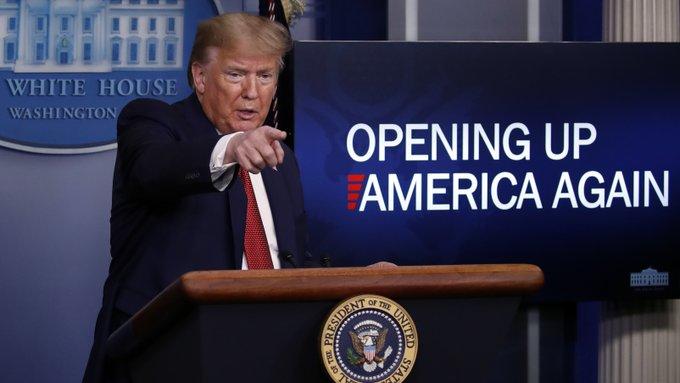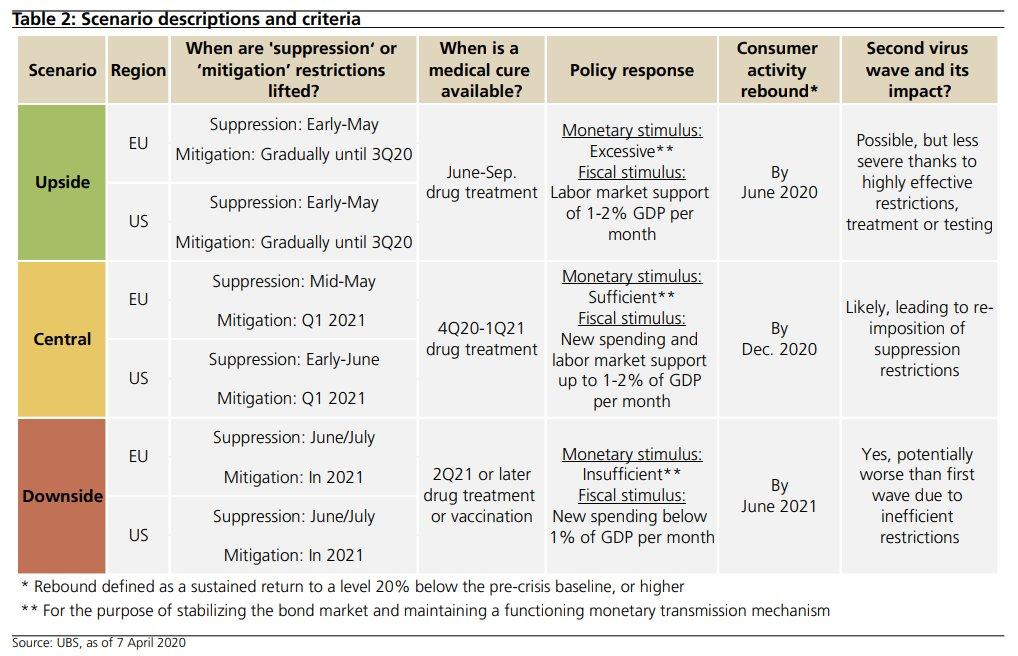Here Are The Problems WIth Trump’s Plan To Reopen The Economy
On Thursday, the Trump administration released a three-phase plan for reopening the economy.
Each phase would ensue after only a 14-day period to determine the impact on health statistics, so in theory the “new normal” could be achieved in 28 days. If this were to actually happen it would be very bullish for the economy and markets. However the actual pace of re-opening will be determined by the states, not the federal government.
Here are the details:
- Phase one: most restrictions remain in place, but “some large public places — including restaurants, movie theaters, sporting venues and places of worship — would be allowed to operate under strict physical distancing protocols. Elective surgeries could resume and gyms could reopen as long as they maintained physical distancing.”
- Phase two: nonessential travel resumes, schools reopen and bars open with “diminished standing room occupancy.”
- Phase three: this is essentially the “new normal”. Assuming downward trends in cases, allow “public interactions” with physical distancing and unrestricted staffing of worksites, resume visits to care homes and hospitals, and further ease capacity restrictions at bars.
There are problems, starting with the fact not a single state currently meets the criteria for a reduction in new covid cases:
The first criteria for Trump’s reopening plan? States must have a 14-day downward trajectory of COVID-19 cases.
How many states currently meet that criteria? Zero. pic.twitter.com/Nb7CdKGkCi
— The Recount (@therecount) April 18, 2020
https://platform.twitter.com/widgets.js
That aside, Bank of America notes three potential roadblocks to implementing this plan.
- First and foremost, it is not clear how the US public health system will meet the recommended standards for re-opening. The plan suggests that states looking to re-open should have seen a 14-day downward trend in cases. They should also have: (1) widespread availability of tests, not just for the seriously sick and health care workers, (2) the ability to aggressively track cases and isolate those who may be affected and (3) the ability to quickly and independently supply enough medical equipment and increase ICU capacity to meet surge demand. Alas, all three of these conditions will be challenging to meet.
- A second concern is that the 14-day waiting period between phases is too short to determine the impact of the rule changes on the course of the disease. That is the incubation period for an individual case, but in group situations incubation occurs in a rolling fashion. In addition, people might wait a few days to get tested after their symptoms arrive and it takes time for tests to be completed. Therefore, only people who got infected as soon as restrictions were lifted would test positive within a 14-day window. And if a new outbreak occurs, the number of infections would probably be higher later in that window. Given these considerations, we expect states to wait at least a month to move from one phase of the plan to the next.
- Third, the devil is in the details. The plan offers very little insight into how social distancing can be practiced in activities that involve large crowds:
- How can a bar possibly require that people have masks on at all times and stand at least six feet apart?
- How do you get thousands of people in and out of a sports arena without a massive increase in the number of close contacts?
- Even if people sit 6 feet apart, they still need to go through turnstiles, visit the bathroom and buy food and drink. The same applies for larger concerts, church services, public transportation, etc.
In summary, private businesses will adopt a conservative approach even if they are allowed to re-open. For example, the MLB is talking about bringing back baseball games only in Arizona (where the outbreak has been relatively contained), with no crowds and players isolated in hotels. The PGA is not planning to resume golf tournaments until at least June.
BofA’s conclusion: the Trump admin plan is a nice outline of the economic side of the reopening process, however, when governors look to implement the re-opening they will need to address all of these issues—adequate testing and tracking, time to assess the impact of policy changes and details of how to maintain six-feet and other social distancing rules.
There is also the “resistance” dimension which has to be considered, namely that it is not unlikely that one or more governors may delay reopening their states just to impair the economy and thus Trump’s chances of re-election. Of course, by doing so said governors also risk a violent public backlash with an increasing percentage of the population demanding a return to normalcy, and as such any forced delays – or fabricated data and/or projections – could end up being a double-edged sword.
In any case, the release of Trump’s ambitious plan does not impact BofA’s economic forecasts, and the bank continues to expect a very slow reopening process, with most of the re-engagement happening in June.
Incidentally, while it remains to be seen how efficient the Trump plan will be, here is a matrix from UBS which lays out an Upside, Central and Downside scenario for a longer-term view of a US reopening…
… which suggests that a return to normalcy may take place anywhere between Q4 of 2020 in the best case, or be delayed as far back as 2021, by which point the US economy – stuck in a nearly two-year depression – will be pale shadow of its former self.
Tyler Durden
Sat, 04/18/2020 – 16:00![]()
Zero Hedge’s mission is to widen the scope of financial, economic and political information available to the professional investing public, to skeptically examine and, where necessary, attack the flaccid institution that financial journalism has become, to liberate oppressed knowledge, to provide analysis uninhibited by political constraint and to facilitate information’s unending quest for freedom. Visit https://www.zerohedge.com

